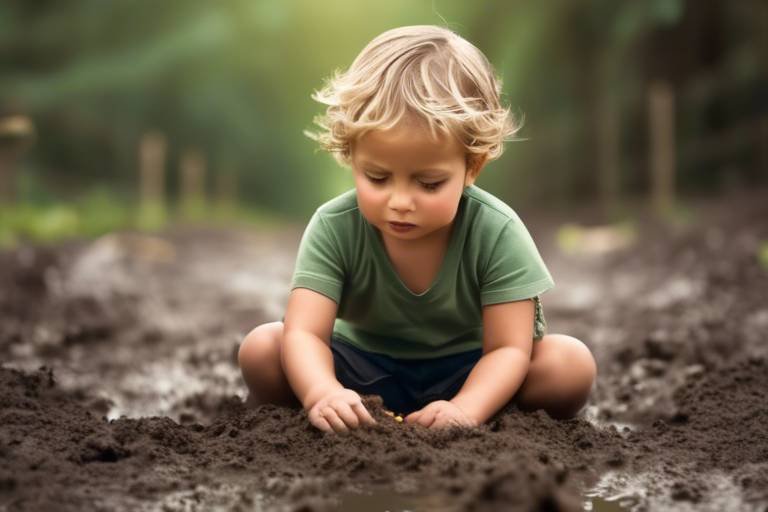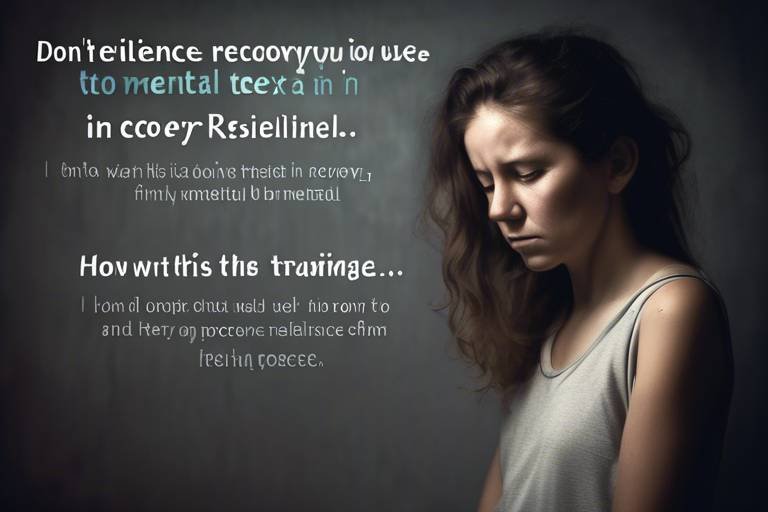Can we Instill Confidence in our Children?
Confidence is like a secret ingredient that can transform the way our children approach life. Imagine a world where your child faces challenges with a smile, embraces new experiences without hesitation, and believes in their abilities wholeheartedly. Instilling confidence in our children is not just a lofty ideal; it’s a crucial part of parenting that can shape their futures in remarkable ways. But how do we go about fostering this essential trait? In this article, we will explore various strategies and insights on nurturing confidence through parenting, education, and social interactions, emphasizing the importance of a positive self-image and resilience.
Parenting styles significantly influence a child's confidence. Think of parenting as the foundation of a house; if the foundation is weak, the entire structure is at risk. Authoritative parenting, characterized by warmth and structure, tends to produce children who feel secure and confident. On the other hand, permissive parenting may lead to children who struggle with boundaries, impacting their self-esteem. It's essential to find a balance that encourages independence while providing support. Engaging in open conversations, setting realistic expectations, and modeling confidence in your own life can all contribute to building a child's belief in themselves.
Fostering independence in children is crucial for building confidence. Allowing children to make decisions, even small ones, can significantly boost their self-reliance. Think about it: when a child chooses their outfit or decides what snack to have, they're practicing decision-making skills. This autonomy helps them learn from their mistakes, promoting resilience. For instance, if a child decides to try a new sport but struggles initially, they learn that it's okay to not succeed right away. They can be encouraged to keep trying, which builds a strong sense of perseverance.
Experiencing failure is a vital part of growth. It’s often said that failure is the best teacher, and this couldn’t be more accurate when it comes to building confidence in children. When kids face challenges, they get the opportunity to develop a healthy perspective on setbacks. Instead of fearing failure, they learn to embrace it as a stepping stone to success. This mindset shift is crucial; it allows them to understand that mistakes are not the end of the world but rather an essential part of learning.
A supportive environment is essential for children to take risks. Parents and educators play a pivotal role in creating a safe space where children feel comfortable exploring and learning from their failures. This can be achieved by encouraging open discussions about mistakes and celebrating the effort rather than just the outcome. When children know they can take risks without the fear of harsh judgment, they're more likely to step outside their comfort zones and try new things.
Recognizing and celebrating achievements, no matter how small, boosts a child's self-esteem. Positive reinforcement is a powerful tool in nurturing confidence. When children receive praise for their efforts, it reinforces the idea that hard work leads to success. This doesn’t mean showering them with empty compliments; instead, focus on specific achievements. For example, if your child completes a difficult puzzle, acknowledge their persistence and problem-solving skills. This reinforces their belief in their capabilities and motivates them to tackle future challenges.
Social interactions play a vital role in confidence development. Teaching children effective communication and interpersonal skills can enhance their self-assurance in various social settings. Whether it’s initiating a conversation with a new friend or expressing their feelings, these skills are essential for building relationships. Encourage your child to participate in group activities, as these experiences help them navigate social dynamics and build confidence in their ability to connect with others.
Educational environments can greatly influence a child's confidence. Schools are not just places for academic learning; they are also social arenas where children develop their self-esteem. Teachers and schools can implement strategies to foster a positive learning atmosphere that encourages self-efficacy. For instance, creating a classroom culture that values collaboration over competition can help children feel more secure in their abilities and less fearful of failure.
Active participation in classroom activities can enhance a child's confidence. When children are encouraged to share their ideas and contribute to discussions, they begin to see themselves as valuable members of the learning community. This sense of belonging is crucial for building self-esteem. Teachers can facilitate this by creating opportunities for all students to express themselves, whether through group projects, presentations, or class discussions.
Constructive feedback is essential for growth. Providing children with specific, actionable feedback helps them understand their strengths and areas for improvement, fostering a growth mindset. Instead of simply telling a child they did a great job, delve deeper. For example, highlight what they did well and suggest ways they can improve. This approach not only boosts their confidence but also encourages them to take ownership of their learning journey.
- How can I tell if my child is lacking confidence? Look for signs such as reluctance to try new activities, excessive fear of failure, or difficulty making friends.
- What are some daily activities to boost my child's confidence? Encourage them to set small goals, celebrate their achievements, and allow them to make choices in their daily routines.
- Is it okay to let my child fail? Absolutely! Failure is a crucial part of learning and helps children develop resilience and problem-solving skills.

The Role of Parenting
Parenting is like the foundation of a house; if it's strong and well-constructed, the house stands tall and proud. Similarly, the way parents interact with their children can significantly shape their confidence levels. Different parenting styles, such as authoritative, permissive, and uninvolved, have unique impacts on a child's self-esteem and belief in their abilities. For instance, authoritative parents, who balance warmth with structure, tend to raise children who are more confident and self-reliant. In contrast, permissive parents may create a nurturing environment but often fail to set boundaries, which can lead to children struggling with self-discipline and confidence in their decision-making skills.
Moreover, it’s essential to recognize that parenting is not a one-size-fits-all approach. Each child is unique, and what works for one may not work for another. It’s crucial for parents to adapt their strategies to meet the individual needs of their children. This might involve being more hands-on with a shy child while allowing a more adventurous child the freedom to explore and learn independently. The key here is to strike a balance between guidance and independence, allowing children to discover their strengths and weaknesses.
In the table below, we can see a comparison of different parenting styles and their impacts on children's confidence:
| Parenting Style | Characteristics | Impact on Confidence |
|---|---|---|
| Authoritative | Warm, responsive, and sets clear boundaries | Promotes high self-esteem and independence |
| Permissive | Nurturing but lacks structure | Can lead to low self-discipline and confidence |
| Uninvolved | Low responsiveness and low demands | Often results in low self-esteem and insecurity |
By understanding these dynamics, parents can actively choose approaches that nurture their child's confidence. It’s also crucial for parents to engage in open communication with their children. Asking questions like, “How do you feel about that?” or “What do you think you could do differently next time?” encourages children to reflect on their experiences and learn from them. This not only builds their problem-solving skills but also fosters a sense of autonomy.
Additionally, parents should be mindful of their own behaviors and attitudes, as children often mirror what they see. If a parent demonstrates confidence in their own abilities and approaches challenges with a positive mindset, children are likely to adopt similar attitudes. This modeling of behavior is a powerful tool in instilling confidence in children. So, the next time you face a challenge, remember that your response could shape your child’s perception of their own abilities.

Encouraging Independence
Encouraging independence in children is not just about giving them the freedom to make choices; it’s about equipping them with the skills to navigate the world confidently. Think of it like teaching a child to ride a bike. At first, they may wobble and fall, but with practice and a little guidance, they learn to balance and steer on their own. This process is essential for building a strong foundation of self-esteem and resilience. So, how can we effectively foster this independence?
One of the first steps is to allow children to make decisions, even if those choices seem trivial to us. For instance, letting them pick out their clothes or choose what to have for dinner can empower them. It’s about giving them the reins, even if it’s just a little bit. When children feel that their opinions matter, they begin to trust their judgment, which is a critical aspect of confidence. However, it’s also important to let them experience the consequences of their choices, whether good or bad.
To illustrate, let’s consider a scenario where a child decides to wear mismatched socks to school. While it might seem insignificant, this simple choice can lead to a valuable lesson about self-expression and the acceptance of differences. If they face teasing, it’s an opportunity for parents to step in, not to shield them from the experience, but to discuss how to handle such situations. This approach teaches children that while they can express themselves, they must also be prepared for the reactions of others.
Moreover, encouraging independence means allowing children to learn from their mistakes. This can be a tough pill to swallow for parents who naturally want to protect their kids from failure. However, failure is a powerful teacher. When children face challenges and make mistakes, they develop resilience—the ability to bounce back and try again. For example, if a child struggles with a school project, rather than stepping in to do it for them, guiding them through the problem-solving process can be far more beneficial. This approach not only builds their confidence but also enhances critical thinking skills.
Creating a safe environment is crucial for fostering independence. Children need to feel secure enough to take risks. This means establishing a home and school atmosphere where mistakes are seen as a natural part of learning. Parents and educators can achieve this by:
- Encouraging open communication about feelings and experiences.
- Reassuring children that it’s okay to fail and that they are supported no matter the outcome.
- Modeling resilience by sharing personal stories of overcoming challenges.
Lastly, it’s essential to celebrate achievements, no matter how small. Recognizing a child’s effort can significantly boost their self-esteem and encourage them to take on new challenges. Whether it’s a simple “great job” after they’ve successfully completed a task or a more elaborate celebration for a significant accomplishment, positive reinforcement plays a vital role in nurturing a child’s confidence. It’s like watering a plant; without the right amount of care and encouragement, it may struggle to grow.
In conclusion, fostering independence in children is a multifaceted approach that requires patience, understanding, and a willingness to let them explore. By allowing them to make choices, learn from their mistakes, and providing a supportive environment, we can help them build the confidence they need to thrive in life.
- How can I encourage my child to make decisions? Start with small choices, like what to wear or what game to play. Gradually introduce more significant decisions as they become more comfortable.
- What if my child makes a poor choice? Use it as a teaching moment. Discuss what happened and how they might approach the situation differently next time.
- How do I create a safe environment for my child? Foster open communication and reassure them that mistakes are part of learning. Encourage them to express their feelings and thoughts without fear of judgment.

The Importance of Failure
Failure is often viewed as a negative experience, but in reality, it serves as a powerful teacher. When children encounter setbacks, they are presented with invaluable opportunities for growth and development. It's essential to understand that failure is not the end of the road; rather, it is a stepping stone toward success. Just like a caterpillar must struggle to break free from its cocoon to become a butterfly, children too must learn to navigate challenges to build their confidence and resilience.
When children face difficulties, they learn critical life skills such as problem-solving, perseverance, and adaptability. These skills are crucial for their emotional and social development. By allowing children to experience failure, we help them cultivate a healthy perspective on challenges. Instead of fearing failure, they begin to see it as a natural part of the learning process. This shift in mindset can significantly impact their self-esteem and willingness to take risks in the future.
Moreover, it’s important to frame failure in a constructive light. When discussing setbacks with children, we can emphasize that failure is simply feedback. For instance, instead of saying, “You failed at this task,” we can rephrase it to, “This didn’t work out this time, but what can we learn from it?” This approach encourages children to analyze their experiences and understand that mistakes are not a reflection of their worth but rather an opportunity to improve.
To illustrate the importance of failure, consider the following examples:
- Famous Innovators: Many successful individuals, such as Thomas Edison and J.K. Rowling, faced numerous failures before achieving their dreams. Their stories remind us that persistence in the face of failure can lead to remarkable outcomes.
- Everyday Learning: In academic settings, when a child struggles with a math problem, it is a chance for them to explore different strategies and learn from their mistakes. This process not only improves their skills but also boosts their confidence when they eventually succeed.
By allowing children to experience failure in a safe environment, we equip them with the tools they need to handle life's challenges. Rather than shielding them from difficulties, we should encourage them to embrace the learning that comes from setbacks. This approach fosters resilience, enabling them to bounce back stronger and more self-assured than before.
In conclusion, failure should not be feared but embraced as a crucial aspect of personal growth. By teaching children to navigate their failures with grace and curiosity, we instill in them a sense of confidence that will serve them well throughout their lives.
Q1: How can I help my child cope with failure?
A1: Encourage open discussions about their experiences and feelings. Help them reframe failure as a learning opportunity and guide them in identifying what they can do differently next time.
Q2: Is it okay to let my child fail?
A2: Absolutely! Allowing children to fail in a supportive environment helps them build resilience and problem-solving skills, which are essential for their development.
Q3: What role does encouragement play in handling failure?
A3: Encouragement is vital. It reassures children that they are not alone in their struggles and that failure is a part of the journey toward success.

Creating a Safe Environment
Creating a safe environment for children is crucial in fostering their confidence and encouraging them to take risks. Imagine a garden: if the soil is rich and the conditions are just right, plants can thrive. Similarly, children need a nurturing atmosphere where they feel secure and supported to explore their abilities. This involves more than just physical safety; it encompasses emotional and psychological security as well.
To establish such an environment, parents and educators can implement several strategies that promote a sense of safety and belonging. First and foremost, it’s essential to encourage open communication. When children feel they can express their thoughts and feelings without fear of judgment, they are more likely to share their fears and challenges. This dialogue helps them understand that it’s okay to struggle and that they are not alone in their experiences.
Another vital aspect is to create consistent routines and boundaries. Children thrive on predictability. When they know what to expect, they can navigate their world with greater confidence. Setting clear expectations helps them understand the consequences of their actions, allowing them to make decisions within a safe framework. Here’s a simple table summarizing these key elements:
| Key Element | Description |
|---|---|
| Open Communication | Encouraging children to share their feelings and thoughts without fear of judgment. |
| Consistent Routines | Providing predictability in daily activities to help children feel secure. |
| Positive Reinforcement | Recognizing and celebrating achievements to boost self-esteem. |
Additionally, it’s important to model a growth mindset. Children learn a lot by observing adults. When they see their parents or teachers embracing challenges and viewing failures as opportunities for growth, they are more likely to adopt the same attitude. This modeling can be reinforced through discussions about personal experiences, where adults share their own struggles and triumphs, thus normalizing the concept of failure as a stepping stone to success.
Creating a safe environment also means allowing children to engage in problem-solving and decision-making. When they are given the freedom to make choices, even small ones, it instills a sense of ownership and responsibility. For instance, letting them choose their clothes or decide on a family activity empowers them, making them feel capable and valued. This autonomy is a crucial ingredient in building their self-confidence.
Furthermore, fostering relationships with peers in a safe setting enhances their social skills and emotional intelligence. Encourage playdates, group activities, and team sports, as these interactions teach children how to navigate social dynamics and build friendships. When they feel accepted by their peers, their confidence soars, and they become more resilient in facing challenges.
In summary, creating a safe environment is about nurturing a space where children feel valued, understood, and empowered. By fostering open communication, establishing routines, modeling resilience, and encouraging independence, we lay the groundwork for children to become confident individuals who are not afraid to take risks and learn from their experiences.
- What are some signs that my child lacks confidence? Look for signs such as avoidance of new activities, reluctance to speak up in groups, or excessive self-criticism.
- How can I help my child overcome a fear of failure? Encourage them to view failure as a learning opportunity and share your own experiences with setbacks.
- Is it okay to let my child make mistakes? Absolutely! Mistakes are essential for growth and learning, helping children develop resilience.

Celebrating Achievements
Celebrating achievements is a fundamental aspect of nurturing a child's confidence and self-esteem. When we recognize and applaud even the smallest victories, we send a powerful message that their efforts are valued and appreciated. This practice not only boosts their self-worth but also motivates them to strive for further accomplishments. Think of it like watering a plant; without regular nourishment, it struggles to grow. Similarly, children need positive reinforcement to flourish emotionally and psychologically.
So, how can parents and educators effectively celebrate achievements? It's not just about throwing a big party for every little success; it's about creating a culture of recognition in everyday life. Here are a few practical ways to celebrate achievements:
- Verbal Praise: Simple words of encouragement can go a long way. A heartfelt “I’m proud of you!” can make a child’s day and instill a sense of accomplishment.
- Reward Systems: Consider implementing a reward system for specific goals. This could be as simple as a sticker chart or a points system that leads to a fun outing.
- Sharing Success: Encourage children to share their achievements with family and friends. This not only validates their efforts but also helps them practice communication skills.
Moreover, celebrating achievements shouldn't be limited to just academic or athletic successes. It can include personal milestones, such as overcoming a fear or learning a new skill. For instance, if a child learns to ride a bike without training wheels, that moment deserves recognition! These celebrations help children understand that growth comes in many forms and that every step forward is worth acknowledging.
Additionally, creating a visual representation of achievements can be incredibly motivating. Consider setting up a “Wall of Fame” at home or in the classroom where children can display their accomplishments, whether it's artwork, certificates, or photos of special moments. This not only boosts their self-esteem but also serves as a constant reminder of their capabilities.
In essence, celebrating achievements is about building a positive feedback loop. When children feel celebrated, they are more likely to take on challenges, knowing that their efforts will be recognized. This creates a resilient mindset, where they learn to value persistence and hard work. Remember, confidence is not built overnight; it's a gradual process that flourishes through consistent encouragement and recognition of efforts.
Q: Why is celebrating small achievements important?
A: Celebrating small achievements helps children build self-esteem and motivates them to pursue further goals. It reinforces the idea that their efforts are valuable.
Q: How can I celebrate my child's achievements without making it a big deal?
A: You can offer verbal praise, create a reward system, or encourage them to share their successes with family and friends to celebrate in a meaningful yet low-key manner.
Q: Should I celebrate all achievements or only significant ones?
A: It's important to celebrate both small and significant achievements. Recognizing small wins helps children see progress and feel encouraged to tackle bigger challenges.

Building Social Skills
When it comes to nurturing a child's confidence, social skills play an absolutely pivotal role. Think about it: children are like little sponges, soaking up everything around them, especially when it comes to interacting with their peers. The way they communicate, express themselves, and engage in conversations can significantly shape their self-assurance. So, how can we help them develop these essential skills? Well, it starts with creating opportunities for social interaction. Encourage playdates, group activities, and team sports. These experiences not only provide children with a chance to interact with others but also teach them the importance of teamwork and collaboration.
Moreover, it’s crucial to model effective communication. Children learn a lot by observing their parents and guardians. When they see you engage in conversations—whether it’s discussing your day with a friend or negotiating a situation—they pick up on those skills. Use active listening techniques, such as nodding and maintaining eye contact, to demonstrate how to engage in meaningful dialogue. This not only boosts their confidence but also teaches them the value of being present in conversations.
Additionally, teaching children to express their feelings and thoughts clearly can be a game-changer. When they can articulate their emotions, they feel more in control and less anxious in social situations. You can practice this at home by encouraging them to share their day or discuss a book they read. Ask open-ended questions that prompt them to elaborate, like, “What was the best part of your day?” This not only helps them practice their communication skills but also strengthens your bond.
Another vital aspect is teaching children how to navigate social challenges. Conflict resolution is a skill that will serve them well throughout life. Encourage them to talk through disagreements with peers rather than resorting to anger or withdrawal. Role-playing different scenarios can be an effective way to prepare them for real-life situations. For example, you might simulate a situation where they need to share a toy or take turns, guiding them on how to express their needs and negotiate effectively.
Lastly, let’s not forget the importance of empathy. Understanding and relating to the feelings of others is a cornerstone of social interaction. Encourage your child to consider how others might feel in different situations. Simple activities, such as reading stories and discussing the characters' emotions, can foster this skill. When children learn to empathize, they not only build stronger relationships but also boost their own confidence by feeling more connected to those around them.
In summary, building social skills in children is not just about encouraging them to make friends; it's about equipping them with the tools they need to navigate the complex world of human interaction. By fostering effective communication, teaching conflict resolution, and nurturing empathy, we can help our children develop a strong sense of self-assurance that will serve them well throughout their lives.
- What are some signs that my child needs help with social skills? Look for signs such as difficulty making friends, frequent conflicts with peers, or anxiety in social situations.
- How can I encourage my shy child to engage more socially? Start by arranging small, low-pressure playdates and gradually increase social interactions as they become more comfortable.
- Is it normal for children to struggle with social skills? Yes, many children go through phases where they find social interactions challenging. It's a normal part of development.

Role of Education
Education plays a pivotal role in shaping a child's confidence. It is not just about acquiring knowledge; it's about creating an environment that nurtures self-belief and encourages children to explore their potential. When children feel supported and valued in their educational settings, they are more likely to develop a positive self-image and a strong sense of competence. Think about it: when a child walks into a classroom where their ideas are heard and their efforts are acknowledged, they are more likely to participate actively and take on challenges. This leads to a cycle of success, where confidence breeds further confidence.
Moreover, the way educators approach learning can significantly impact a child's self-esteem. Teachers who adopt inclusive practices, offer diverse learning opportunities, and foster a collaborative atmosphere can empower students to express themselves freely. For instance, when children are encouraged to share their thoughts during discussions or collaborate on projects, they learn to trust their voices and opinions. This not only enhances their communication skills but also builds a sense of belonging and acceptance within the classroom.
In addition to fostering a supportive atmosphere, it’s essential for educators to implement strategies that actively engage students. One effective method is to encourage participation in various classroom activities. When children are invited to contribute to discussions, work on group projects, or even lead presentations, they gain valuable experience in public speaking and teamwork. This hands-on involvement can significantly boost their confidence, making them feel like integral parts of their learning community.
Furthermore, providing constructive feedback is crucial in the educational journey. Children need to understand their strengths and areas for improvement, but it's equally important that this feedback is delivered in a way that promotes growth. For instance, instead of merely pointing out mistakes, educators can highlight what a child did well and suggest specific ways to enhance their performance. This approach not only encourages a growth mindset but also helps children view challenges as opportunities for learning rather than obstacles. Here’s a simple comparison of feedback styles:
| Feedback Style | Impact on Confidence |
|---|---|
| Positive Reinforcement | Boosts self-esteem and encourages continued effort |
| Constructive Criticism | Promotes growth and resilience when delivered thoughtfully |
| Negative Feedback | Can diminish confidence and discourage participation |
Finally, it’s essential to recognize that education extends beyond the classroom. Parents and caregivers play a critical role in reinforcing the lessons learned at school. When they engage in their child's education—whether by attending school events, discussing homework, or celebrating academic achievements—they send a powerful message about the importance of learning and self-improvement. This partnership between home and school creates a holistic approach to building confidence in children.
In conclusion, the role of education in fostering confidence cannot be overstated. It is a collaborative effort that involves teachers, parents, and the community working together to create an environment where children feel safe to explore, learn, and grow. By encouraging participation, providing constructive feedback, and fostering a supportive atmosphere, we can help children develop the confidence they need to navigate life's challenges successfully.
- How can I help my child feel more confident in school? Encourage them to participate in class, praise their efforts, and provide a safe space for them to express their thoughts.
- What should I do if my child struggles with self-esteem? Focus on their strengths, celebrate small achievements, and consider seeking support from a counselor or educator.
- Can failure actually help build confidence? Yes! Experiencing failure teaches resilience and helps children develop a healthy perspective on challenges.

Encouraging Participation
Encouraging participation in classroom activities is more than just getting kids to raise their hands; it's about creating an environment where they feel valued and capable. When children actively engage in their learning, they not only absorb knowledge but also build their confidence. Think of it like planting a seed. The more sunlight and water you provide, the stronger the plant grows. Similarly, the more opportunities we give our children to participate, the more they flourish.
One effective way to encourage participation is through interactive learning. This could involve group discussions, hands-on projects, or even role-playing activities. When children see that their contributions matter, they are more likely to engage. For instance, a teacher might implement a project where students work in teams to solve a problem, allowing each child to take on a specific role. This not only fosters teamwork but also helps children realize that their unique skills are essential to the group's success.
Moreover, it's crucial to create a welcoming atmosphere where mistakes are seen as learning opportunities rather than failures. When children feel safe to express their ideas without fear of judgment, they are more inclined to participate. A teacher could establish a classroom norm that encourages questions and celebrates curiosity. This could be as simple as saying, "There are no silly questions here!" Such affirmations can significantly boost a child's willingness to engage.
Another strategy is to use positive reinforcement. When a child participates, whether it's answering a question or sharing a thought, acknowledging their effort with praise can motivate them to continue participating. For instance, saying, "Great job sharing your idea! That really added to our discussion," can make a world of difference. This kind of feedback not only boosts their confidence but also encourages them to take initiative in future discussions.
Additionally, consider implementing peer-led activities. Children often feel more comfortable participating when they see their peers leading discussions or activities. This can be done through student presentations or group-led discussions. When children see their classmates taking charge, it can inspire them to step out of their comfort zones and join in. It's like giving them a gentle nudge towards growth.
In conclusion, encouraging participation is a multifaceted approach that involves creating a supportive environment, using positive reinforcement, and fostering peer interactions. By implementing these strategies, we can help children develop a sense of belonging and confidence, ultimately paving the way for them to thrive both academically and socially.
- Why is participation important for children's confidence?
Participation helps children feel valued and capable, reinforcing their belief in their abilities. - How can I encourage my child to participate more in school?
Try to create a supportive environment at home that celebrates their efforts and encourages questions. - What role does a teacher play in encouraging participation?
Teachers can create engaging activities, provide positive feedback, and foster a safe space for students to express themselves.

Providing Constructive Feedback
When it comes to nurturing a child's confidence, is like handing them a roadmap for success. It’s not just about telling them what they did wrong; it’s about guiding them to understand their strengths and areas for improvement. Imagine trying to navigate through a dense forest without a map—frustrating, right? That's how children feel when they receive vague or negative feedback. Instead, we want to equip them with the tools they need to find their way.
Constructive feedback should be specific, actionable, and delivered in a way that encourages growth. For instance, instead of saying, "You need to do better in math," you might say, "I noticed you struggled with fractions on your last test. Let’s practice some problems together." This approach not only highlights the issue but also opens the door for collaboration and learning. By framing feedback positively, you help children see challenges as opportunities rather than obstacles.
Additionally, it’s important to balance criticism with praise. Children thrive when they feel recognized for their efforts. A simple acknowledgment like, "I really liked how you approached that problem!" can boost their motivation to tackle more difficult tasks. Here’s a quick breakdown of how to strike that balance:
| Type of Feedback | Example | Impact |
|---|---|---|
| Positive Reinforcement | "You did a great job on your presentation!" | Boosts confidence and encourages future efforts. |
| Constructive Criticism | "Your argument was strong, but let’s work on your delivery." | Promotes growth while maintaining self-esteem. |
| Vague Feedback | "You need to improve." | Leaves the child confused and demotivated. |
Moreover, timing is crucial when delivering feedback. Offering insights immediately after an activity allows children to connect the dots between their actions and the feedback they receive. Think of it as a coach giving a player tips during a game rather than after the final whistle. This real-time feedback helps solidify learning and builds a sense of competence.
Lastly, encourage children to self-reflect on their work. Ask them questions like, "What do you think went well?" or "What would you do differently next time?" This not only fosters a growth mindset but also empowers them to take ownership of their learning journey. By making them active participants in the feedback process, we help them develop resilience and the confidence to face future challenges.
- What is constructive feedback? Constructive feedback is specific, actionable, and aimed at helping someone improve while also recognizing their strengths.
- How can I give effective feedback to my child? Focus on being specific, balancing praise with constructive criticism, and encouraging self-reflection.
- Why is feedback important for building confidence? Feedback helps children understand their abilities, learn from mistakes, and fosters a growth mindset, all of which contribute to greater self-confidence.
Frequently Asked Questions
- How can parenting styles affect a child's confidence?
Parenting styles play a crucial role in shaping a child's self-esteem. For instance, authoritative parenting, which combines warmth with structure, often leads to higher confidence levels in children. In contrast, permissive parenting may result in children struggling with self-discipline and confidence. It's all about finding the right balance!
- What are some effective ways to encourage independence in children?
Encouraging independence can be as simple as allowing children to make their own choices, whether it’s picking out their clothes or deciding how to solve a problem. Providing opportunities for them to learn from their mistakes fosters resilience and self-reliance, which are key components of confidence.
- Why is experiencing failure important for children?
Failure is often seen as a setback, but in reality, it's a stepping stone to growth! When children face challenges and learn to navigate them, they develop a healthy perspective on setbacks. This not only builds their confidence but also equips them with the skills to tackle future obstacles.
- How can parents create a safe environment for their children?
A supportive environment is essential for children to feel secure while exploring new things. Parents can create this space by encouraging open communication, showing unconditional love, and allowing kids to take risks without fear of harsh criticism. This way, children feel empowered to learn from their experiences.
- What role does celebrating achievements play in building confidence?
Celebrating even the smallest achievements can have a huge impact on a child's self-esteem. Positive reinforcement helps children recognize their capabilities, making them more likely to take on new challenges. It's like planting seeds of confidence that can grow into something beautiful!
- How can social skills influence a child's confidence?
Social interactions are fundamental to building confidence. Teaching children effective communication and interpersonal skills equips them to navigate various social settings with ease. When they feel comfortable expressing themselves, their self-assurance naturally increases.
- What can educators do to foster a positive learning atmosphere?
Educators can create a supportive learning environment by encouraging participation and valuing each child's input. This not only makes children feel important but also enhances their confidence in their abilities. A classroom where everyone feels heard is a classroom where confidence thrives!
- Why is constructive feedback essential for children's growth?
Constructive feedback helps children understand their strengths and areas for improvement. By providing specific, actionable suggestions, educators and parents can foster a growth mindset, encouraging children to view challenges as opportunities for learning rather than threats to their self-esteem.



















